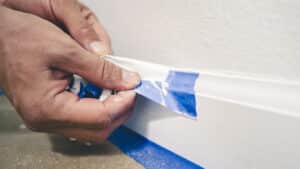Everything You Need to Know About Decorator’s Tape
Having the right equipment for the job can make all the difference, especially when you’re attempting to create straight lines and clean edges. Decorator’s tape is an essential in your kit to ensure you get perfect paint results every time, with no bleed. In this handy guide, we’ve put together everything you need to know about decorator’s tape and how to use it.
Quick Navigation
- What is the difference between Decorator’s Tape and Masking Tape?
- Can you paint over decorator’s tape?
- How long do I need to wait before painting?
- What happens if you leave painter’s tape on too long?
- How do you remove decorator’s tape without peeling away paint?
- How long do I need to wait before I can use decorator’s tape on fresh paint?
- Can you leave painters tape in place for multiple coats?
- Should you remove decorator’s tape when the paint is wet or dry?
- Should you paint the trim of a room or the walls first?
- How do professional painters get straight lines?

What is the difference between Decorator’s Tape and Masking Tape?
Although all masking tapes serve the same purpose – protecting an underlying layer from a fresh coat of paint, you will need to use the right kind of tape for the surface that you are working on and the type of paint that you are using.
Decorator’s tapes are designed to be used with thicker paint that is applied with a brush or roller, whereas automotive masking tapes are used on metal or plastic surfaces where thin layers are sprayed.
Decorator’s tapes do not need to withstand the higher temperatures used to cure paints, and as such can use different types of adhesives that make them easier to remove without leaving a residue once the job is finished.
Can you paint over decorator’s tape?
Good quality decorator’s tape is designed to protect the underlying surface from the layer of paint being applied, so it is perfectly OK to paint over it. Having said that, if you buy a low-quality masking tape or one that has not been designed for the type of painting that you are doing, it may be too thin to properly protect the wall. A poor-quality masking tape may allow some paint to soak through to the wall below, and if the adhesive is not good enough, you could be in a situation where paint can bleed under the tape and affect the edge.
If decorator’s tapes are not stored carefully, the adhesive can degrade over time, so before you start painting, check that the tape is properly fixed in place and can be removed.
How long do I need to wait before painting?
Once you have applied the decorator’s tape to walls or room trim, it is a good idea to allow some time for the adhesive to properly bind the tape to the wall.
Try and give the tape around half an hour to an hour in place before you start to paint on it. Depending on the amount of masking that you have had to do before starting to paint, once you have finished applying the tape, you may well be able to paint against the masking tape that you applied first.
What happens if you leave painter’s tape on too long?
Decorator’s masking tape is designed to be left in place for the duration of a job and then removed.
If tapes are left in place for too long, the adhesive can start to degrade and either peel away from the wall which would allow paint to bleed underneath it or stick too firmly and cause damage to the surface when removed.
Most high quality painters tapes can stay in place for 14 days or more before being removed with no issues, although if the paintwork has been completed, and the paint is allowed to harden for too long, removing the tape will be more likely to crack the edge of the painted area and cause some damage, so ideally you should remove the tape as soon as the paint has started to dry.
How do you remove decorator’s tape without peeling away paint?
Damaging the fresh paint after you have finished a job is frustrating and can result in the job taking a lot longer if you need to sand back to a smooth finish, so ensuring that you remove the tape without peeling the paint away at the same time is essential.
It is best to remove the decorator’s tape before the layer of paint is completely dry, but when it has started to harden.
Start by scoring along the edge of the tape with a razor blade to separate it from the paint on the wall and causing the paint to crack.
Once you have satisfactorily scored a line, carefully peel the tape away from the wall. Go slowly and aim to pull the tape away at a 45-degree angle away from the area that you have painted.
How long do I need to wait before I can use decorator’s tape on fresh paint?
Before applying fresh masking tape to a wall, you need to wait until the previous layer of paint is fully dry so that it is properly attached to the wall. If you apply tape to a freshly painted surface before the paint is properly dry, you will almost certainly pull the paint away when removing the tape after finishing your job.
Allow at least 24 hours before you apply tape on top of a layer of new paint, and ideally choose a low tack product specifically designed for this purpose.
Can you leave painters tape in place for multiple coats?
If you want to achieve the best results when painting walls, it is always better to use fresh masking tape for every coat. The reason for this is simple: removing the decorator’s tape from the wall is easier and will do less damage to the new layer of paint if it is still slightly wet. If the paint is allowed to dry fully, it loses some elasticity and may chip when removed.
Painting multiple coats without changing the masking tape will mean that there are several layers of dried paint that can be pulled away.
Should you remove decorator’s tape when the paint is wet or dry?
If paint is allowed to dry fully before the masking tape is removed, the tape is more likely to tear some of the paint away as you peel it, but if you remove the tape too early, particularly on vertical surfaces, some paint may start to run.
The trick is to remove decorator’s tape from the walls once the paint has begun to dry, but while it is still flexible.
Peel the tape away as carefully as possible at a 45-degree angle and do not “drag” the tape on the surface. If you start to hear a ripping noise, slow down to avoid damaging your finish.
Should you paint the trim of a room or the walls first?
In most cases, you would want to paint the trim around the room first. Start with doorframes, skirting boards and window frames. Be careful to mask the walls while painting so that you don’t get a gloss paint onto the wall or ceiling that could affect your finish.
While waiting for the paint on trim to dry, many professionals will concentrate on the ceiling.
Once the ceiling is complete and the paint on any trim in the room is dry, use a good quality decorator’s tape to mask the edges of the room, cut in around detailed areas, and finish by filling in the main wall areas.
Once the job is complete, carefully peel away the masking tape and step back to admire a job well done.
How do professional painters get straight lines?
The most effective way of ensuring that you get straight lines when painting is to use a decorators masking tape
No paint job is complete without decorator’s tape, giving you a neat, professional finish every time. No matter how big or small the job, using decorator’s tape can help you to paint efficiently, while protecting the areas you don’t want to paint. For more information about our range of masking tapes, please contact a member of our team, or visit our online store to see our products.


